TL;DR
Quickest way to make a basement bathroom less creepy: add warm 2700–3000K lighting, close the ceiling, level footing, and hide exposed pipes. If your toilet sits on a raised platform, extend the deck 10–14 inches so feet don’t dangle. These steps answer how to make a basement bathroom less creepy without a full gut.
Basement bathroom lighting and layout: why it feels creepy
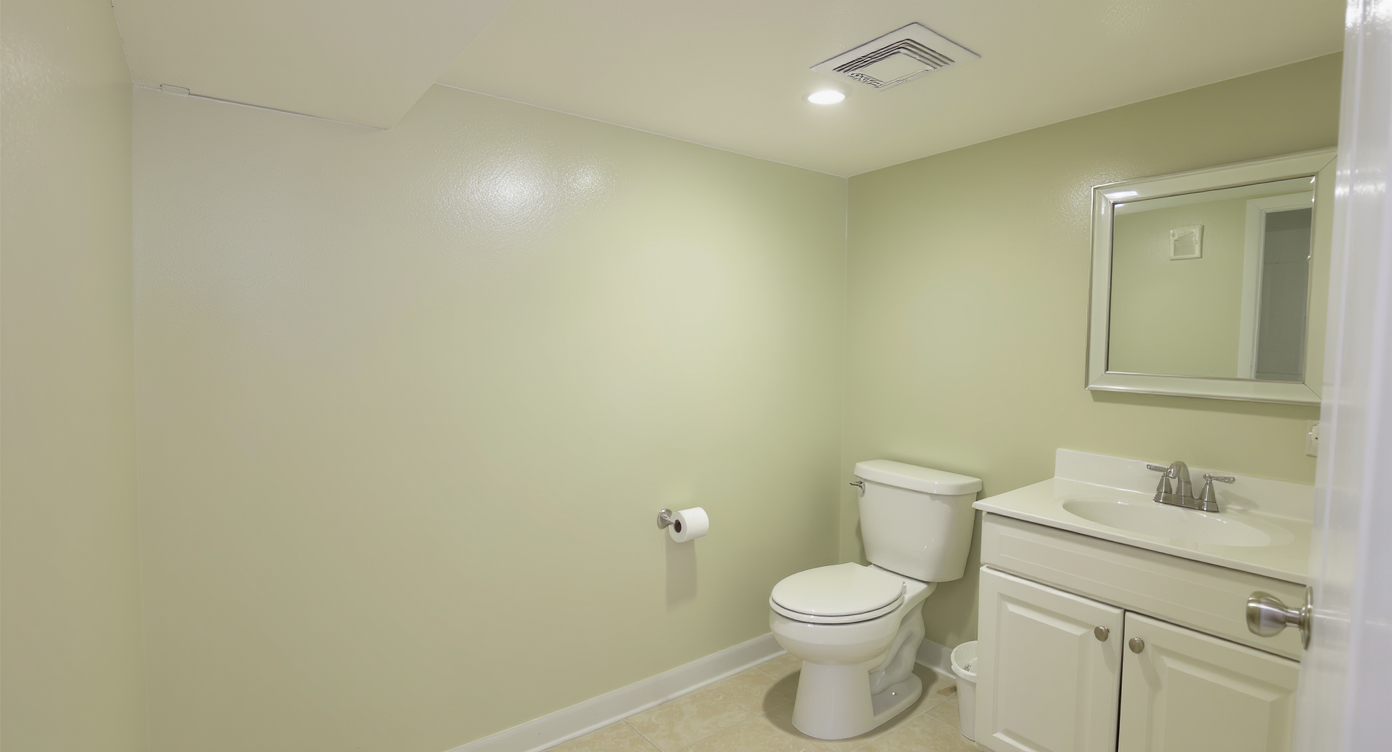
Soft light, finished ceiling, and calm colors help lift a basement bathroom’s mood instantly.
Here’s the thing about a “creepy” basement bathroom: it’s almost never the toilet’s fault. It’s the darkness, the exposed rafters, the echo, and that improvised outlet above the sink. Humans avoid shadowy corners; basements have plenty. Fix the shadows and the unfinished bits, and the mood flips.
Designers often note that three moves change the vibe the fastest: warm, even lighting; a finished or visually unified ceiling; and secure footing near the toilet and sink. Add a mirror and calm color, and suddenly the space reads “bathroom,” not “utility room.” If you’re dealing with a raised toilet platform (common over slab drains or macerators), plan a safe step or extend the deck so legs don’t dangle.
One more reality check: safety is part of the vibe. A proper GFCI outlet near the vanity, an exhaust fan (at least 50 CFM, or about 1 CFM per square foot), and no mystery cords through walls do as much for peace of mind as any paint color.
Core strategy: lighting, ceiling, safe footing, and clean lines
Start with light: aim for roughly 50–70 lumens per square foot at 2700–3000K, then address the ceiling and footing before you worry about décor.
- Upgrade lighting first. Use warm 2700–3000K LEDs, CRI 90+ if you can. One ceiling light plus a vanity light reduces shadows. For a 40 sq ft bath, that’s about 2,000–2,800 lumens total. Avoid cool, bluish light; it amplifies concrete and pipe textures.
- Close or visually unify the ceiling. A drop ceiling keeps access and hides plumbing. Minimum comfortable clearance is about 80 inches; if height is tight, paint the joists and pipes a single matte color (many pros prefer black or deep navy) so the “void” disappears.
- Fix footing at the toilet. If the toilet sits on a platform, extend the deck 10–14 inches to create a landing or add a sturdy step (18–24 inches wide). People won’t use a perch that makes their legs dangle. Keep a 24-inch clear space in front of the bowl and at least 15 inches from bowl centerline to side walls.
- Hide or organize pipes. Box out vertical stacks with a slim removable chase; leave access to cleanouts. Horizontal runs can sit behind a soffit or be painted to match walls for an industrial look.
- Make it code‑safe. Replace the vanity outlet with a GFCI and get rid of any cord passing through a wall. Add a quiet exhaust fan (50–80 CFM for small baths) to dry the space and cut odors. Experts recommend venting outdoors, not into the joist cavity.
- Refresh touch surfaces. Swap a tired vanity for a narrow pedestal or 18–24 inch cabinet to gain elbow room. Hang a mirror 5–10 inches above the faucet; a medicine cabinet doubles storage and hides wall scars.
- Flooring that warms the eye. Click LVP or quality peel‑and‑stick vinyl over a flat underlayment looks clean and bright. Lighter, low‑pattern floors bounce light; medium grout‑tone rugs add warmth at sink and step.
User insight: People trust spaces that look intentional. When lights switch on instantly, the ceiling reads finished, and the toilet feels stable, the “basement” label fades and guests stop avoiding the room.
Anecdote
A homeowner joked their bath felt like a “boiler room.” After adding a matte-black painted ceiling, two 3000K can lights, and a 12-inch platform extension at the toilet, guests stopped avoiding it—and they stopped avoiding hosting.
Common mistakes when fixing a basement bathroom
Most basement bathrooms feel creepy because of poor lighting, exposed structure, and unsafe details; fix these first and décor second.
- Thinking one bright bulb fixes everything. A lone overhead throws harsh shadows. Use layered light: ceiling plus vanity, both warm white.
- Painting without prep. Skipping cleaning, patching, or priming cinder block (use masonry primer) leads to blotchy, institutional walls.
- Ignoring GFCI and the exhaust fan. A standard outlet above a sink is risky. Bathrooms need GFCI protection and at least a 50 CFM fan in windowless rooms.
- Leaving the raised toilet as-is. Dangling feet = instant “nope.” Add a step or extend the platform so knees sit at a comfortable height.
- Dropping the ceiling too low. Don’t box yourself in; if height is scarce, paint the ceiling instead of installing a grid.
Pro tips from designers and builders
Designers often recommend CRI 90+ LEDs and a drop ceiling for access in basement bathrooms; both reduce shadows and future headaches.
- Use dimmable, warm LEDs. A 2700K–3000K range with a high CRI keeps skin tones natural and tile colors true. Add a motion night‑light for safe midnight trips.
- Paint the lid “away.” If you can’t close the ceiling, spray the joists and pipes a single matte color. Dark recesses visually recede; the room feels finished without losing access.
- Mirror math. Choose a mirror at least as wide as the sink (or 2–3 inches narrower than the vanity) and center the light 66–70 inches off the floor for most users.
- Ventilation rule of thumb. Fan CFM ≈ room square footage (minimum 50 CFM). In damp basements, many pros step up to 80 CFM for reliability.
- Plan a weekend sprint. Day 1: demo clutter, electrical/GFCI swap, prime and paint. Day 2: ceiling solution, lighting, flooring, mirror, and accessories.
Quick reflection: the goal isn’t “magazine perfect”; it’s bright, safe, and intentional. When that lands, people stop cracking jokes about horror movies and start using the room.
Anecdotes and real stories from real homes
Real‑world fixes show how small upgrades—lighting, a step, a mirror—change behavior overnight.
- The platform problem. A homeowner extended the toilet deck by 12 inches with a hinged access panel over the cleanout. Result: no more dangling feet, and guests actually used the space.
- Painted ceiling magic. Another family couldn’t spare height for a grid, so they painted the open ceiling matte black and added two slim can lights. The rafters visually disappeared.
- The “mystery cord” era ends. One DIYer swapped the vanity outlet for a GFCI, added a mirrored cabinet, and re‑routed a cord to a proper receptacle in the adjacent room. Safety and storage in one afternoon.
- Renter hack. In a leased basement, fabric panels stapled between joists, plug‑in sconces, a peel‑and‑stick floor, and a freestanding TP holder transformed the vibe without touching the plumbing.
Image ideas and alt text: “Basement bathroom after warm 3000K lighting and drop ceiling” and “Raised toilet platform with added landing for safe footing.”
Visualization Scenario
Step into warm, even light. The joists overhead are gone behind a clean grid, and a narrow vanity sits under a softly glowing mirror. A slim soffit hides the stack, the floor runs in a light oak vinyl, and the toilet platform extends forward so your feet land confidently. Nothing buzzes, nothing dangles, and the room finally feels like part of the house.
FAQ: basement bathroom lighting, layout, and safety
- How do I make a basement bathroom less creepy on a budget?
Start with warm 2700–3000K LED lighting, a painted or drop ceiling, and a mirror; then add peel‑and‑stick vinyl flooring. These quick upgrades tackle the biggest perception issues for under a few hundred dollars. - What lighting is best for a basement bathroom?
Use layered warm light: a 2700–3000K ceiling fixture plus a vanity light, totaling about 50–70 lumens per sq ft. High CRI (90+) LEDs keep colors natural and reduce harsh shadows. - How can I hide exposed pipes in a basement bathroom?
Build a removable drywall chase or soffit around stacks and runs, leaving access to cleanouts. Where covering isn’t possible, paint pipes the wall color to visually recede. - What can I do about a raised toilet platform?
Extend the platform 10–14 inches or add a sturdy step so feet rest flat; keep a 24‑inch clear space in front. If budget allows, a macerating or ejector system can lower the fixture to floor level. - Do I need a GFCI outlet and exhaust fan in a basement bathroom?
Yes. Bathrooms require GFCI protection at the vanity and a fan of at least 50 CFM (≈ room sq ft), vented outdoors. These safety upgrades reduce moisture and add confidence.
Wrap-up: Bright, safe, ergonomic wins
If you make it bright, safe, and ergonomic, the “creepy” label disappears. Warm layered lighting, a finished (or unified) ceiling, confident footing, and clean lines are the fastest wins. Hide or organize the pipes, upgrade to a GFCI, add a mirror, and pick a calm color that bounces light. You’ll be amazed how quickly a “Saw set” becomes a solid little bath.
Want to preview styles before you commit? Drop a photo into ReimagineHome to test paint, vanities, and layouts in minutes.
.svg)

.svg)
.jpg)
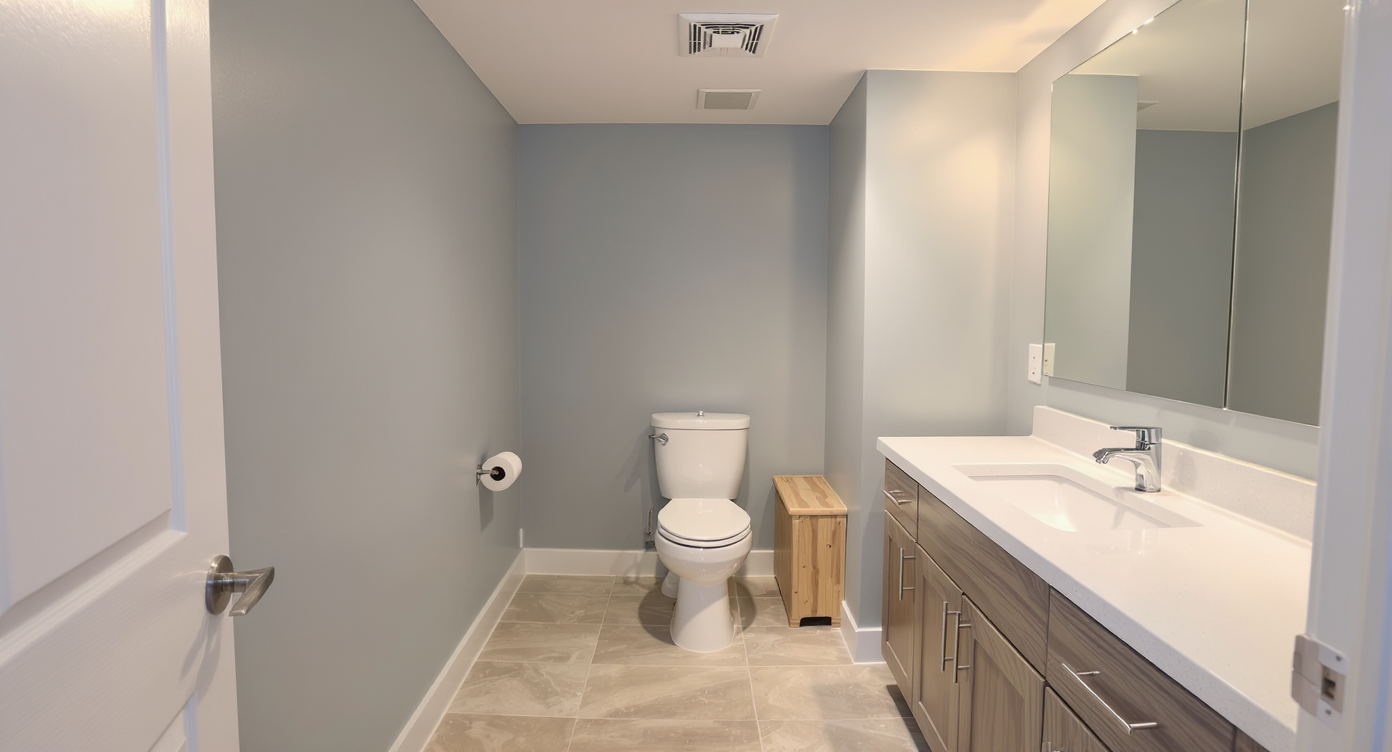



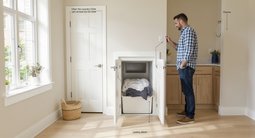

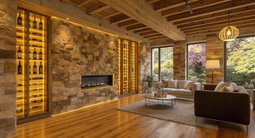
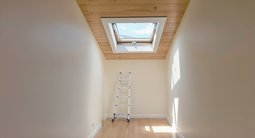


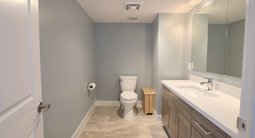


.png)